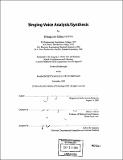| dc.contributor.advisor | Barry L. Vercoe. | en_US |
| dc.contributor.author | Kim, Youngmoo E | en_US |
| dc.contributor.other | Massachusetts Institute of Technology. Dept. of Architecture. Program In Media Arts and Sciences. | en_US |
| dc.date.accessioned | 2011-04-04T16:15:40Z | |
| dc.date.available | 2011-04-04T16:15:40Z | |
| dc.date.copyright | 2003 | en_US |
| dc.date.issued | 2003 | en_US |
| dc.identifier.uri | http://hdl.handle.net/1721.1/62044 | |
| dc.description | Thesis (Ph. D.)--Massachusetts Institute of Technology, School of Architecture and Planning, Program in Media Arts and Sciences, 2003. | en_US |
| dc.description | Includes bibliographical references (p. 109-115). | en_US |
| dc.description.abstract | The singing voice is the oldest and most variable of musical instruments. By combining music, lyrics, and expression, the voice is able to affect us in ways that no other instrument can. As listeners, we are innately drawn to the sound of the human voice, and when present it is almost always the focal point of a musical piece. But the acoustic flexibility of the voice in intimating words, shaping phrases, and conveying emotion also makes it the most difficult instrument to model computationally. Moreover, while all voices are capable of producing the common sounds necessary for language understanding and communication, each voice possesses distinctive features independent of phonemes and words. These unique acoustic qualities are the result of a combination of innate physical factors and expressive characteristics of performance, reflecting an individual's vocal identity. A great deal of prior research has focused on speech recognition and speaker identification, but relatively little work has been performed specifically on singing. There are significant differences between speech and singing in terms of both production and perception. Traditional computational models of speech have focused on the intelligibility of language, often sacrificing sound quality for model simplicity. Such models, however, are detrimental to the goal of singing, which relies on acoustic authenticity for the non-linguistic communication of expression and emotion. These differences between speech and singing dictate that a different and specialized representation is needed to capture the sound quality and musicality most valued in singing. | en_US |
| dc.description.abstract | (cont.) This dissertation proposes an analysis/synthesis framework specifically for the singing voice that models the time-varying physical and expressive characteristics unique to an individual voice. The system operates by jointly estimating source-filter voice model parameters, representing vocal physiology, and modeling the dynamic behavior of these features over time to represent aspects of expression. This framework is demonstrated to be useful for several applications, such as singing voice coding, automatic singer identification, and voice transformation. | en_US |
| dc.description.statementofresponsibility | by Youngmoo Edmund Kim. | en_US |
| dc.format.extent | 115 p. | en_US |
| dc.language.iso | eng | en_US |
| dc.publisher | Massachusetts Institute of Technology | en_US |
| dc.rights | M.I.T. theses are protected by
copyright. They may be viewed from this source for any purpose, but
reproduction or distribution in any format is prohibited without written
permission. See provided URL for inquiries about permission. | en_US |
| dc.rights.uri | http://dspace.mit.edu/handle/1721.1/7582 | en_US |
| dc.subject | Architecture. Program In Media Arts and Sciences. | en_US |
| dc.title | Singing voice analysis/synthesis | en_US |
| dc.type | Thesis | en_US |
| dc.description.degree | Ph.D. | en_US |
| dc.contributor.department | Program in Media Arts and Sciences (Massachusetts Institute of Technology) | |
| dc.identifier.oclc | 54910864 | en_US |
